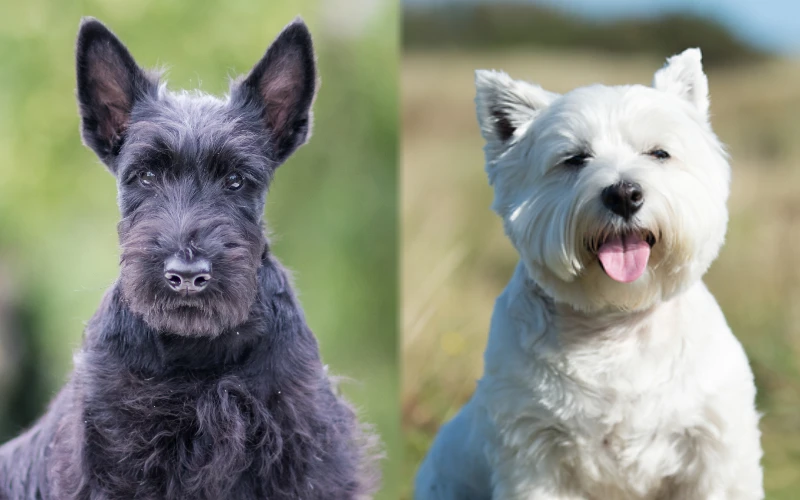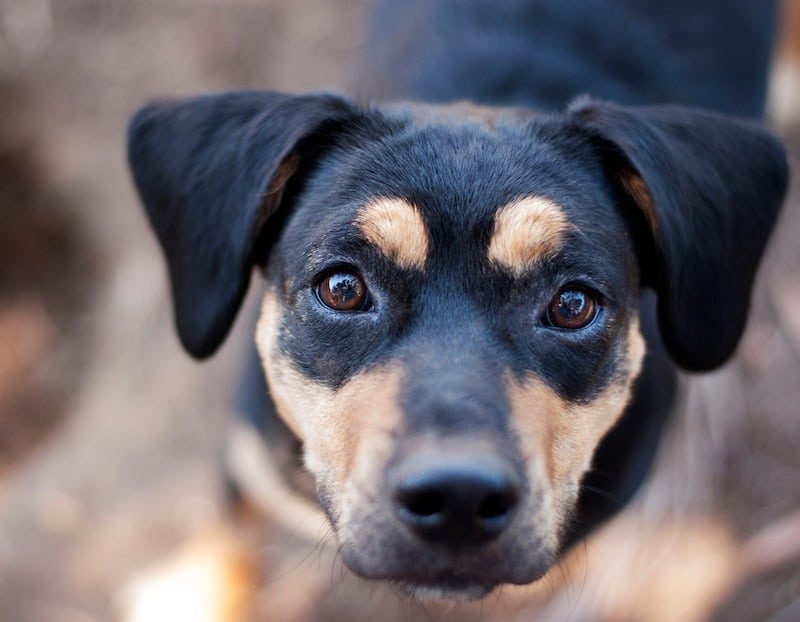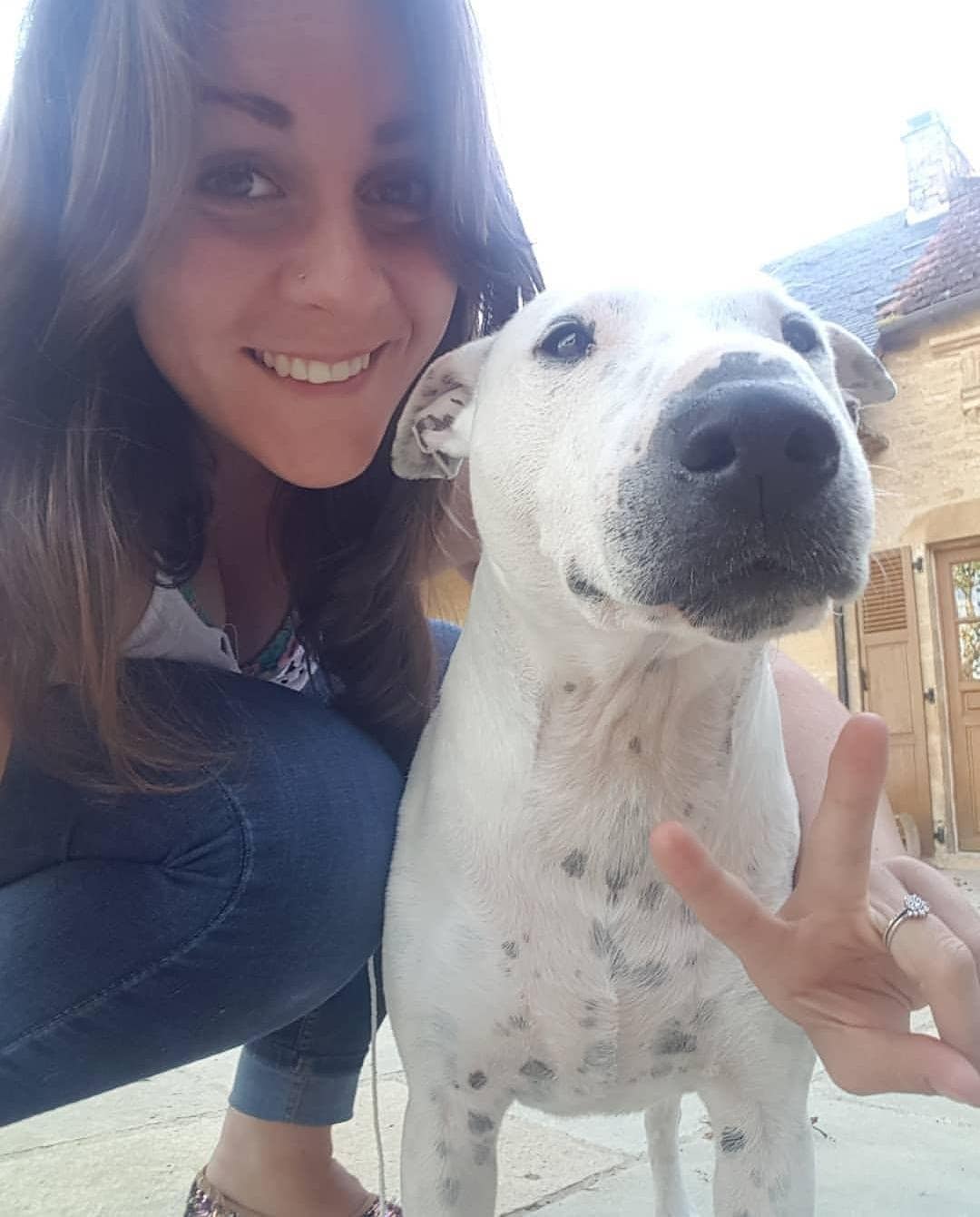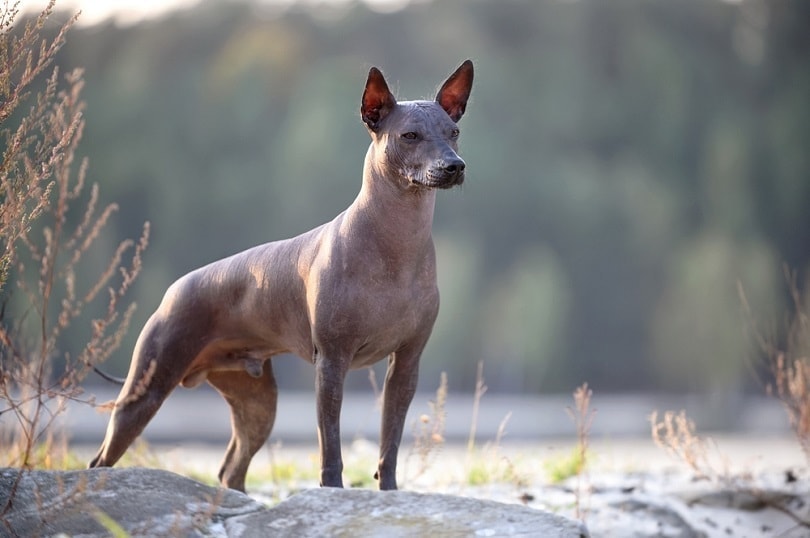Great Dane | Dog Breed Info: Pictures, Traits & Facts

Updated on

| Height: | 26—34 inches |
| Weight: | 110—200 pounds |
| Lifespan: | 7—10 years |
| Colors: | Fawn, blue, brindle, black, harlequin, mantle, merle, white |
| Suitable for: | Families with plenty of space and time for a dog of massive stature |
| Temperament: | Intelligent, gentle, guardian, friendly, courageous, spirited, sweet, noble |
Though originally bred from Mastiff-type canines, Great Danes have become far more refined than any other modern Mastiff descendants. They’ve still maintained their massive size, but this breed was once ferocious. Today, they’re some of the gentlest dogs you’ll meet, despite weighing up to 200 pounds and standing nearly three feet tall at the shoulders.
Great Danes have a very interesting history. They’ve been around for so long that there’s even art depicting Dane-like canines from ancient Egypt, though the breed has gone through some major changes since then. Even today, they’re some of the largest dogs on the planet. In fact, the tallest dog on record was a Great Dane named Zeus who stood 44 inches tall at the withers.
One of the things that makes Great Danes so attractive is how different they are from other giant breeds. These dogs are known for their tender qualities and are rarely aggressive. They’re also not as energetic as many other large breeds, which means they don’t need a massive yard and tons of exercise each day to remain healthy. Still, they’re not well suited for apartment living based solely on their sheer size.
Great Dane Puppies
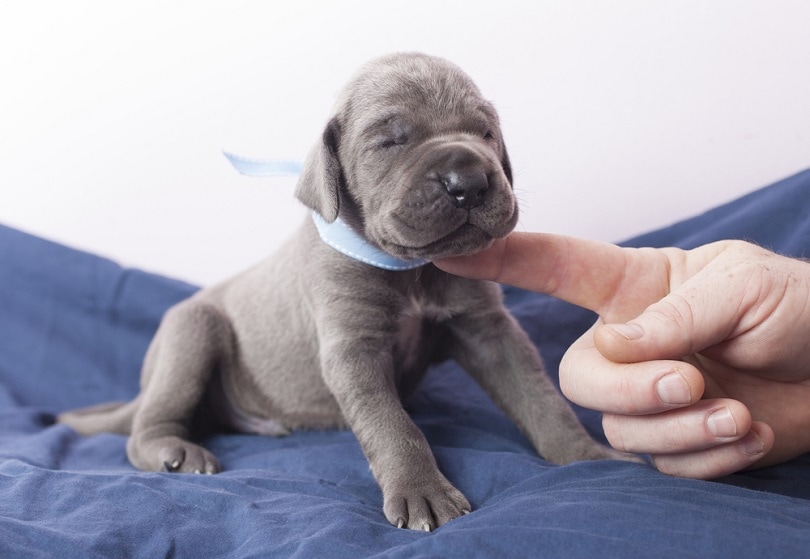
According to the AKC, Great Danes are the 16th most popular canine breed in America. They’re used for dog shows and sports such as agility and are part of the working dog group. Due to these factors and the incredible size of Great Danes, their puppies can be prohibitively expensive. However, a lot depends on what you’re looking for.
If you just want a basic Great Dane puppy from a reputable breeder and you intend to simply keep it as a companion pet, then you won’t be looking for pedigrees and championship bloodlines.
On the other hand, if you’re looking for a show-quality Great Dane with papers and a proven bloodline, then you’re going to be shelling out several times more.
Of course, these prices only cover the cost of the puppy. Bringing a new pup home incurs additional expenses that you’ll also have to plan for, such as a kennel, food, vet visits, health care, and more.
Because they’re so popular, Great Danes are rather common as well. This means that there’s a cheaper avenue to finding a Great Dane puppy if you’re willing to do a little more work. You can find one of these dogs available for adoption at a local shelter or clinic. You’ll be offering one lucky Great Dane pup a second chance at a great and loving life with a new human partner; you.
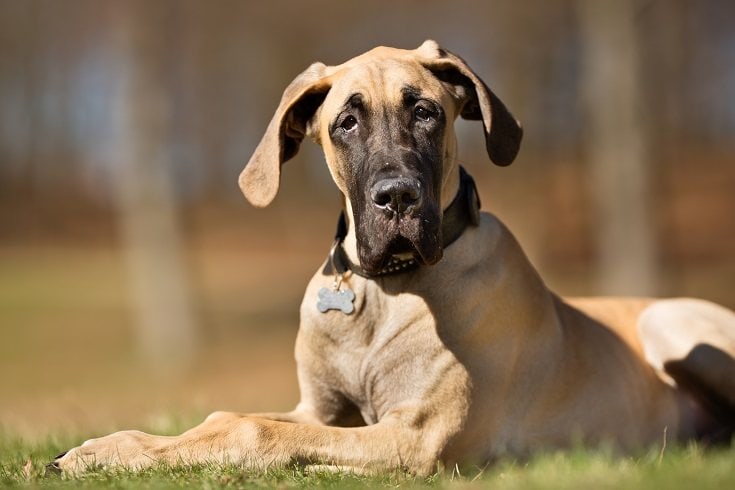
Temperament & Intelligence of the Great Dane 🧠
There’s a reason why Great Danes are known as the gentle giants of the dog world; they’re massive and incredibly gentle and loving. Pretty much anyone who has been around a Great Dane will walk away with the same belief. These dogs are soft-hearted lovers who want affection and attention as much as they want to give it.
More than just lumbering beasts, Great Danes are quite intelligent. They also have a strong desire to please their owners, which helps to make them such perfect family dogs. Of course, you must have plenty of space for a Great Dane. While they don’t need a giant backyard as they’re not the most energetic breed around, they do still need enough room to stretch their legs, which can take up quite a bit of space when you’re that size.
Are These Dogs Good for Families? 🏡
If you have the space and resources to care for such an oversized pet, then Great Danes make great companions for families. Great Danes have a lot of love to give and they want to receive just as much. Having multiple people around to provide love and affection is the perfect environment for a Great Dane.
These dogs are also known for doing great with children. Despite their large size, these dogs are known for being very gentle with those smaller than them. You can find many pictures of young children curled up on their Great Dane protectors. After all, these dogs are incredibly loyal.
While they’re not aggressive under any normal circumstances, you don’t want a Great Dane to believe you’re any type of threat to their family. You’re likely to see a different and much more intimidating side of the breed.
Does This Breed Get Along With Other Pets? 🐶 😽
Just as they get along well with children, Great Danes also get along with other animals. This is a breed with a low prey drive, even though they do have a history of being hunters. Unlike many breeds though, Great Danes were hunters of giant beasts, nothing small. And today, with their gentle disposition, Great Danes are the type of breed that seems to get along with everyone; dogs, cats, kids. Just don’t expect them not to think your hamster is some kind of toy!
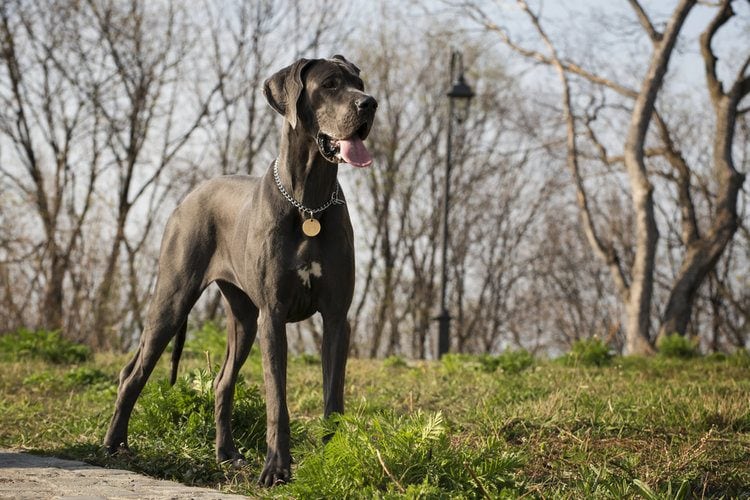
Things to Know When Owning a Great Dane:
Food & Diet Requirements 🦴
Great Danes have specific dietary requirements that must be followed. Failure to do so could result in orthopedic issues due to the breed’s massive size. You’ll need to tailor your Great Dane’s diet to their size at each stage of their life. Still, you should expect a Great Dane to eat far more than most other breeds. In fact, adult males will eat as much as 10 cups of quality dry dog food each day.
Even as a puppy, it’s important that you feed your Great Dane high-quality food that’s specifically formulated for large breeds. You want to make sure you don’t overfeed protein or calcium as these can cause issues for your dog. These foods often include added ingredients to aid your dog’s joint health, but additional supplementation can also be a great idea since Great Danes are susceptible to joint problems.
Another thing to be aware of is the placement of a Great Dane’s feeding bowl. For most dogs, it’s fine to keep their food bowl on the floor, but this will be a problem for a Great Dane whose head is three feet off the floor. These dogs need their food to be at shoulder height to help limit digestive issues.
Exercise 🐕
With most breeds, the amount of exercise they need is directly proportional to the dog’s size. That’s not the case with Great Danes. Though these dogs are huge—as heavy as 200 pounds, they don’t require as much exercise as other large breeds. As such, they don’t need as much living space. You can easily get away with keeping a Great Dane in a smaller home with a moderate-sized yard. It doesn’t have to be anything huge.
Still, it’s important that your Great Dane does get a chance each day to run around and stretch their legs. It’s vital for their health; especially their joints and muscles. You’ll want to give your Great Dane at least 30 minutes of exercise each day. This could be two short walks or a nice play session of fetch. Just remember not to let a Great Dane under 18 months jog or jump as it can damage their growing bones and joints.
Training 🦮
Great Danes are rather intelligent canines. More importantly, they have a strong desire to please their owners. When combined, these traits make the breed quite easy to train. Training is also a great way to increase your bond with your Great Dane, making it a two-fold activity.
This breed excels in basic training as well as more advanced obedience training. They can also be trained for different dog sports, and they typically do very well in agility competitions.
Like with many breeds, Great Danes respond best to positive reinforcement and don’t do well with negativity, yelling, or other similar training methods. In fact, with a Great Dane, these types of methods are likely to cause the dog to behave the opposite of how you intend, so stick with positive reinforcement when training this breed.
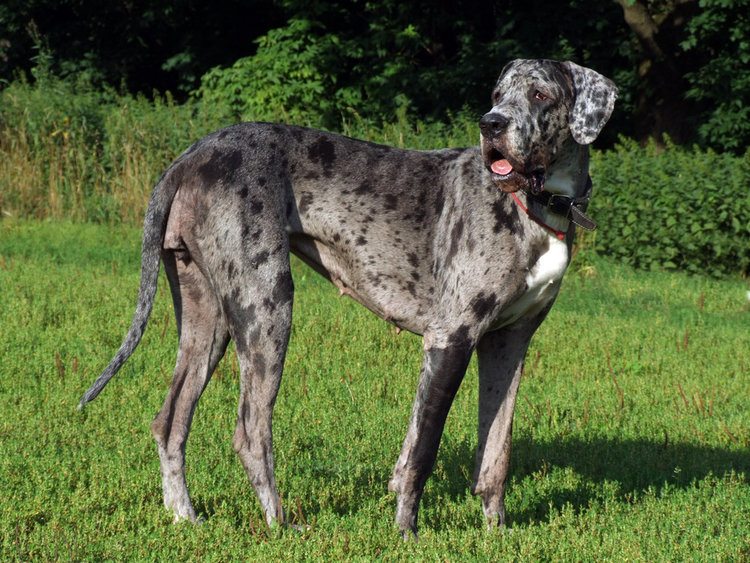
Grooming ✂️
Thankfully, Great Danes are a low-odor and relatively low-maintenance breed that won’t take up much of your time on grooming. Bathing should be kept to a minimum as it can strip essential oils from your dog’s coat and skin. Shedding is moderate unless your dog is suffering from some type of health concern. That said, you’ll have a lot of loose hair around the house with a Great Dane than other breeds, simply due to the dog’s larger size.
For this breed, a quick once over with a brush each day is a great idea. It will keep the shedding mess to a minimum and it’s all the grooming your Great Dane’s coat really needs. Best of all, you can use a cheap rubber curry brush; you don’t need an expensive brush for a Great Dane’s short coat.
Because they drool, you’ll want to sometimes wipe the slobber that forms after meals or drinking time. Eyes can also build mucus that you’ll want to wipe off. Ears should be cleaned once weekly to prevent infections. Like other breeds, you’ll also want to keep your Great Dane’s nails trimmed and teeth clean. Aside from these, you shouldn’t need to perform any special maintenance for your Great Dane.
Health and Conditions ❤️
Great Danes are not known as the healthiest of breeds. To be fair, most large breeds have several common health conditions to contend with. Great Danes don’t live the longest lives; generally, less than 10 years. Any of the following conditions can shorten that lifespan even more, so you’ll want to know exactly what signs and symptoms to watch out for.
Development Issues
Because of their size, great care must be taken with Great Danes as they grow. Developmental issues can arise as a result of damage from something as simple as jumping or jogging before the bones and joints are fully grown.
Hip Dysplasia
This is a relatively common health concern in dogs; particularly in large breeds like Great Danes. It’s when the hip and femur form improperly and the femur rubs on the hip bone, rather than sitting in the hip socket as it should. This causes discomfort, pain, and limited motion. While hip dysplasia can be managed, it will generally increase in severity over the dog’s life.
Bloat
Gastric dilatation-volvulus complex, more commonly known as bloat, is a condition that could spell death for the affected canine. It’s when the dog’s stomach fills with air, building pressure until blood from the rear legs and abdomen can no longer recirculate to the heart. This will result in shock. The stomach can even flip on itself, dragging the pancreas and spleen with it, further halting the flow of blood, which can cause immediate death.
Bone Cancer
Large breeds like Great Danes are highly susceptible to bone cancer. This can result in lameness, lethargy, pain, loss of appetite, and more.
Heart Disease
Several types of heart disease can affect Great Danes, including subaortic stenosis, cardiomyopathy, mitral valve defects, and more. If left unmanaged, this can result in congestive heart failure.
Male vs Female
The most noticeable difference between male and female Great Danes is the size. Males are two inches taller and around 20 pounds heavier than the females. Some people say that females have better focus while males can be a bit more aggressive if pushed. Besides that, both sexes share a lot of similarities.
3 Little-Known Facts About the Great Dane
1. They’re not Danish.
With a name like Great Dane, you might expect the breed to have originated in Denmark, but the name is a misnomer. Great Danes are actually an ancient breed. There’s evidence of similar canines in Babylonian temples from 2000 B.C., Egyptian artifacts from as far back as 3000 B.C., ancient Tibet, and even Chinese literature dating from 1121 B.C. mentions them.
While all of those dogs were ancestors of Great Danes, the breed spread out and was crossed with other large breeds in various parts of the world. It’s thought that the Assyrians brought them on their travels, trading them to the Romans and Greeks who likely mixed them with English Mastiffs, Irish Wolfhounds, and the like.
As massive dogs, these beasts were once used to hunt Boars, earning them the name of Boar Hounds. But in the 1500s, their common name was changed to English Dogges. Soon, nobles in Germany were keeping the most spectacular specimens as pets in their homes, and they received the name of Chamber Dogs or Kammerhunde in German. These pups lived pampered lives of luxury and helped the breed become wildly popular in Germany.
Soon after, a French naturalist by the name of Buffon noted a slimmer, leaner version of the Boar Hound in Denmark, that shared similarities with Greyhounds. Exclaiming that the Danish climate had helped to transform Greyhounds into a Grand Danois. This name of Great Danish Dog was soon adopted, though the largest specimens were called Danish Mastiffs.
Though German breeders are credited with helping to refine the Boar Hound into the breed of gentle giants we know today, the Danish name stuck to the breed. In Germany, they came to call them Deutsche Dogges, but countries that speak English settled on the name of Great Dane, despite the breed’s origins having nothing to do with Denmark.
2. Great Danes shouldn’t jog as puppies.
If you’ve never owned such a massive dog before, you might not be aware of just how much special care is required for such sizable beasts. While most puppies can run, jump, wrestle, and just generally act like puppies, Great Dane puppies have different rules to follow.
Because their bones take a very long time to stop growing and to stabilize fully, Great Dane puppies need to be very careful. They shouldn’t jump, as this can easily damage their unstable bones before they’re fully grown. Additionally, they should never jog as puppies. Until your Great Dane is at least 18 months old, they shouldn’t jog or jump.
Their size will also require some other special considerations. They’re not suited for living in apartments, for instance. Vet visits will cost more, and you’ll even need a big vehicle just to transport your Great Dane around town! Make sure you understand all of the responsibilities that come along with owning such a big dog before you add one to your family.
3. They weren’t always so gentle.
Today, Great Danes are known as incredibly gentle dogs that are even great with children. However, that wasn’t always the case for this big breed. When they were known as Boar Hounds, these beasts had an entirely different temperament.
Boars are giant creatures in their own right, with muscular frames and large tusks that can easily maim. These animals are fast and mean; a hard fight for any creature. But Boar Hounds were such monsters that they could chase these big boars down and trap them until the hunter could arrive to deliver the killing blow.
You can imagine the type of dog it takes to chase down and trap such a ferocious creature as a giant boar. That’s probably not the type of dog you’d want to spend time alone with your child! But Great Danes today have gone through tons of selective breeding to weed out any aggressive behavior that the breed might have had in the past. Now, they’re every bit the gentle giants that people believe them to be, which is part of their incredible and long-lived popularity.
Final Thoughts
Loving, gentle, and great with kids and other pets, Great Danes are an ideal family dog under certain circumstances. While their sweet disposition will endear them to just about anyone, caring for such a large dog is a major responsibility that shouldn’t be undertaken lightly.
Before adding one of these majestic monsters to your family, make sure you understand what goes into caring for something so large. You’ll need to provide plenty of food while still adhering to specific dietary guidelines. Just as importantly, you’ll need lots of space for a dog this size. And don’t forget about the increased costs of vet visits and everything else associated with raising your dog. If you can handle all of these additional expenses and responsibilities, Great Danes are some of the best dogs you could ever fall in love with.
See also:
- Are Great Danes Good with Other Dogs? What to Know!
- Are Great Danes Aggressive? What You Need To Know
Featured Image Credit: Al_Er, Shutterstock


